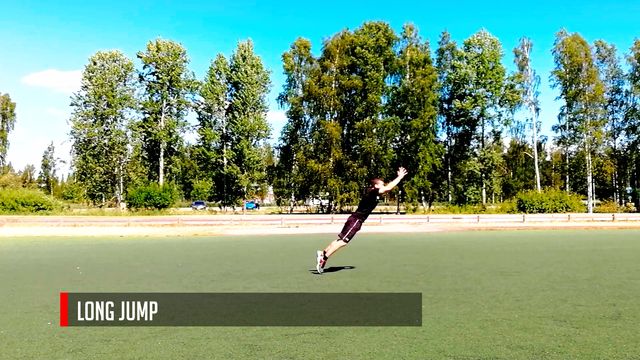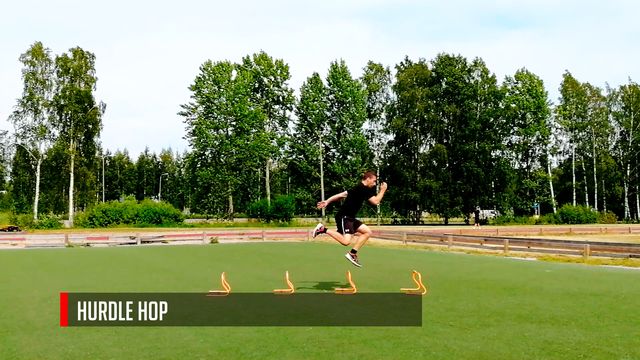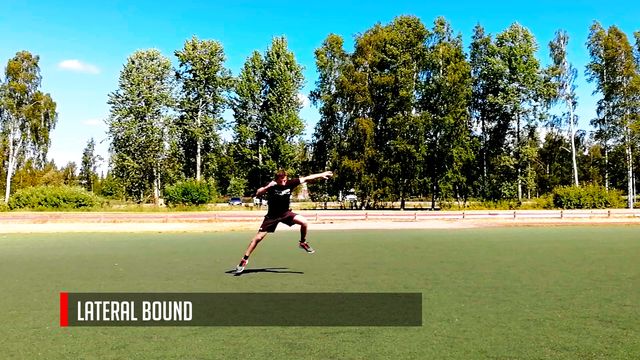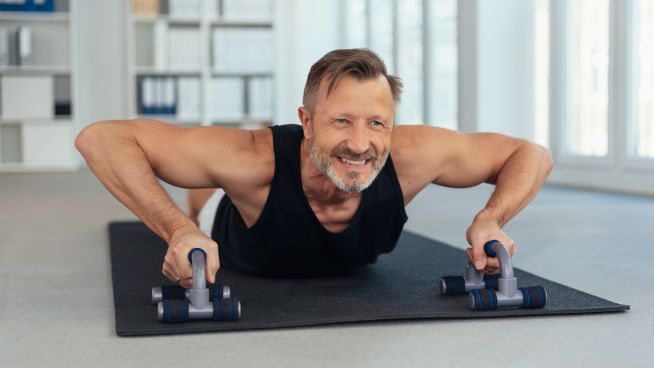Why the Incredible Benefits of Jump Training Go Far Beyond a Higher Vertical
This article is Part 1 in a four-part series on programming and progressing jump training for field sport athletes
Jump training is one of the most popular methods field sport athletes use to improve athletic performance.
Unfortunately it’s also one of the most misunderstood and misapplied methods out there. Ranging from potentially dangerous exercise choices to inappropriate training volumes, your average athlete’s jump workouts leave a lot to be desired when the goal is maximal power development in a safe manner.
In this four-part series, we’ll examine the science and practice of effective jump training so you can become a faster and healthier athlete.
How Jumping Benefits Field Sport Athletes
Being able to jump higher or farther in basketball or volleyball is a no-brainer, because jumping is a big part of these sports. The benefits of a higher vertical leap are obvious in soccer as well—just tally how many header goals Cristiano Ronaldo has scored in his career thanks to his remarkable ability to out-jump defenders.
But how does jumping ability help in hockey, tennis, baseball or football, where most of the action takes place with your feet firmly on the ground?
Without turning this article into a lengthy research review, here’s a small sample of how jump training benefits athletic performance across the board in field sports:
- Agility [1]
- Sprint performance [2]
- Change-of-direction speed [3]
- ACL injury prevention [4]
However, since the adaptations from jump training are primarily neural, it will not cause any significant muscle growth.
Jump Training Terminology
Having established the numerous positive effects jump training can have on athletic performance, let’s shift our focus to exercise terminology.
We need to make sure we’re on the same page here regarding our vocabulary. Why?
If I mention Hurdle Hops and you picture an athlete jumping over a set of hurdles on two legs, we aren’t talking about the same exercise. Likewise, should an image of unilateral bounding pop into your head when discussing Lateral Jumps, then we’ve got a failure in communication. We’ll be using terminology coined by fellow STACK expert Mike Boyle from here on out. [5]
Jump
Jumping and landing on two legs. For example, a Long Jump.
Hop
Jumping and landing on the same leg. For example, a Hurdle Hop.
Bound
Jumping on one leg and landing on the other. For example, a Lateral Bound.
Plyometrics Versus Jump Training
Another important concept I want to address before proceeding any further is Plyometrics.
Plyometric exercises involve the stretch-shortening cycle (stretching and shortening of muscles and tendons) where a rapid eccentric stretch is followed by a powerful concentric contraction. Common jump exercises like Box Jumps, Vertical Jumps or Long Jumps, while often dubbed “plyometric” activities in the Western training literature, are not truly plyometric in nature. How come?
For an action to be deemed plyometric, it has to take advantage of the stretch-shortening cycle, and be executed as quickly and powerfully as possible—usually in 0.15 to 0.2 seconds. [6]
If you’re jumping at your own pace, you’re performing jump training, not plyometrics. Some may argue this is pure semantics, but I believe it’s paramount to stick to proper exercise definitions. In order to be considered a “plyometric” activity, it must be done in a reactive manner with very short ground contact times.
Bottom line? Plyometrics may involve jumping, but not all jumps are plyometric.
If you delve a little deeper into the literature on jump training and plyometrics, you’ll run into different specifications on what does and does not constitute true plyometric exercise.
Whereas the above mentioned recommendation of keeping ground contact times at or below 0.15 to 0.2 seconds for plyometric training stems from Soviet experiments conducted by Dr. Yuri Verkhoshansky, German sport science researcher Dr. Dietmar Schmidtbleicher proposed that the stretch-shortening cycle (SSC) can be classified into two types, fast and slow SSC. [7]
Exercises with short ground contact times (<0.25s) are labeled fast SSC movements. On the other hand, slow SSC exercises involve longer ground contact times (>0.25s).
Fore reference, below is a short list of ground contact times among common athletic activities:
- Sprinting (Usain Bolt, Asafa Powell, Tyson Gay): 0.07-0.091 seconds [8]
- Running vertical jump: 0.23-0.35 seconds [9]
- Running long jump: 0.15-0.17 seconds [9]
- Countermovement jump: 0.5 seconds [10]
- Diagonal bound: 0.45 seconds [11]
- Depth jump off 20-60 cm box: 0.22-0.26 seconds [12]
- Multiple hurdle jumps (hurdle height 60 cm): < 0.15 seconds [13]
- Basketball lay-up shot: 0.218 seconds [14]
Using the 0.25-second mark as the cut-off point for a fast SSC/plyometric activity; sprinting, Long Jumps with a running start, Depth Jumps, Repeat Hurdle Jumps and Lay-Ups with an approach can all be viewed as plyometrics.
On the other hand, Countermovement Jumps and Diagonal Bounds are slow SSC movements and thus, not plyometric exercises.
To avoid confusion, we’ll be referring to any jumping activity—whether it occurs on one or two legs—as jump training, not plyometrics, going forward in this series.
In the next part, we’ll shift our focus from a theoretical foundation into creating more powerful athletes through systematic, progressive jump training in practice.
References:
[1] Miller, MG et al. “The Effects of a 6-Week Plyometric Training Program on Agility.” Journal of Sports Science & Medicine. 2006 Sep; 5(3):459-465. [2] de Villarreal, ES et al. “The Effects of Plyometric Training on Sprint Performance: A Meta-Analysis.” Journal of Strength and Conditioning Research. 2012 Feb; 26(2):575-584. [3] Brughelli, M et al. “Understanding Change of Direction Ability in Sport.” Sports Medicine. 2008 Feb; 38(12):1045-1063. [4] Nessler, T et al. “ACL Injury Prevention: What Does Research Tell Us?” Current Reviews in Musculoskeletal Medicine. 2017 Sep; 10(3):281-288. [5] Boyle, Mike. New Functional Training for Sports. 2nd Edition. Human Kinetics. 2016. [6] Yessis, Michael. Explosive Plyometrics. Ultimate Athlete Concepts. 2009. [7] Schmidtbleicher, D. Training for power events. Strength and Power in Sport. Blackwell Scientific. 1992. [8] Taylor, MJD & Beneke R. “Spring Mass Characteristics of the Fastest Men on Earth.” International Journal of Sports Medicine. 2012 Aug; 33(8):667-670.Photo Credit: StudioThreeDots/iStock
READ MORE FROM YUNUS BARISIK:
RECOMMENDED FOR YOU
MOST POPULAR
Why the Incredible Benefits of Jump Training Go Far Beyond a Higher Vertical
This article is Part 1 in a four-part series on programming and progressing jump training for field sport athletes
Jump training is one of the most popular methods field sport athletes use to improve athletic performance.
Unfortunately it’s also one of the most misunderstood and misapplied methods out there. Ranging from potentially dangerous exercise choices to inappropriate training volumes, your average athlete’s jump workouts leave a lot to be desired when the goal is maximal power development in a safe manner.
In this four-part series, we’ll examine the science and practice of effective jump training so you can become a faster and healthier athlete.
How Jumping Benefits Field Sport Athletes
Being able to jump higher or farther in basketball or volleyball is a no-brainer, because jumping is a big part of these sports. The benefits of a higher vertical leap are obvious in soccer as well—just tally how many header goals Cristiano Ronaldo has scored in his career thanks to his remarkable ability to out-jump defenders.
But how does jumping ability help in hockey, tennis, baseball or football, where most of the action takes place with your feet firmly on the ground?
Without turning this article into a lengthy research review, here’s a small sample of how jump training benefits athletic performance across the board in field sports:
- Agility [1]
- Sprint performance [2]
- Change-of-direction speed [3]
- ACL injury prevention [4]
However, since the adaptations from jump training are primarily neural, it will not cause any significant muscle growth.
Jump Training Terminology
Having established the numerous positive effects jump training can have on athletic performance, let’s shift our focus to exercise terminology.
We need to make sure we’re on the same page here regarding our vocabulary. Why?
If I mention Hurdle Hops and you picture an athlete jumping over a set of hurdles on two legs, we aren’t talking about the same exercise. Likewise, should an image of unilateral bounding pop into your head when discussing Lateral Jumps, then we’ve got a failure in communication. We’ll be using terminology coined by fellow STACK expert Mike Boyle from here on out. [5]
Jump
Jumping and landing on two legs. For example, a Long Jump.
Hop
Jumping and landing on the same leg. For example, a Hurdle Hop.
Bound
Jumping on one leg and landing on the other. For example, a Lateral Bound.
Plyometrics Versus Jump Training
Another important concept I want to address before proceeding any further is Plyometrics.
Plyometric exercises involve the stretch-shortening cycle (stretching and shortening of muscles and tendons) where a rapid eccentric stretch is followed by a powerful concentric contraction. Common jump exercises like Box Jumps, Vertical Jumps or Long Jumps, while often dubbed “plyometric” activities in the Western training literature, are not truly plyometric in nature. How come?
For an action to be deemed plyometric, it has to take advantage of the stretch-shortening cycle, and be executed as quickly and powerfully as possible—usually in 0.15 to 0.2 seconds. [6]
If you’re jumping at your own pace, you’re performing jump training, not plyometrics. Some may argue this is pure semantics, but I believe it’s paramount to stick to proper exercise definitions. In order to be considered a “plyometric” activity, it must be done in a reactive manner with very short ground contact times.
Bottom line? Plyometrics may involve jumping, but not all jumps are plyometric.
If you delve a little deeper into the literature on jump training and plyometrics, you’ll run into different specifications on what does and does not constitute true plyometric exercise.
Whereas the above mentioned recommendation of keeping ground contact times at or below 0.15 to 0.2 seconds for plyometric training stems from Soviet experiments conducted by Dr. Yuri Verkhoshansky, German sport science researcher Dr. Dietmar Schmidtbleicher proposed that the stretch-shortening cycle (SSC) can be classified into two types, fast and slow SSC. [7]
Exercises with short ground contact times (<0.25s) are labeled fast SSC movements. On the other hand, slow SSC exercises involve longer ground contact times (>0.25s).
Fore reference, below is a short list of ground contact times among common athletic activities:
- Sprinting (Usain Bolt, Asafa Powell, Tyson Gay): 0.07-0.091 seconds [8]
- Running vertical jump: 0.23-0.35 seconds [9]
- Running long jump: 0.15-0.17 seconds [9]
- Countermovement jump: 0.5 seconds [10]
- Diagonal bound: 0.45 seconds [11]
- Depth jump off 20-60 cm box: 0.22-0.26 seconds [12]
- Multiple hurdle jumps (hurdle height 60 cm): < 0.15 seconds [13]
- Basketball lay-up shot: 0.218 seconds [14]
Using the 0.25-second mark as the cut-off point for a fast SSC/plyometric activity; sprinting, Long Jumps with a running start, Depth Jumps, Repeat Hurdle Jumps and Lay-Ups with an approach can all be viewed as plyometrics.
On the other hand, Countermovement Jumps and Diagonal Bounds are slow SSC movements and thus, not plyometric exercises.
To avoid confusion, we’ll be referring to any jumping activity—whether it occurs on one or two legs—as jump training, not plyometrics, going forward in this series.
In the next part, we’ll shift our focus from a theoretical foundation into creating more powerful athletes through systematic, progressive jump training in practice.
References:
[1] Miller, MG et al. “The Effects of a 6-Week Plyometric Training Program on Agility.” Journal of Sports Science & Medicine. 2006 Sep; 5(3):459-465. [2] de Villarreal, ES et al. “The Effects of Plyometric Training on Sprint Performance: A Meta-Analysis.” Journal of Strength and Conditioning Research. 2012 Feb; 26(2):575-584. [3] Brughelli, M et al. “Understanding Change of Direction Ability in Sport.” Sports Medicine. 2008 Feb; 38(12):1045-1063. [4] Nessler, T et al. “ACL Injury Prevention: What Does Research Tell Us?” Current Reviews in Musculoskeletal Medicine. 2017 Sep; 10(3):281-288. [5] Boyle, Mike. New Functional Training for Sports. 2nd Edition. Human Kinetics. 2016. [6] Yessis, Michael. Explosive Plyometrics. Ultimate Athlete Concepts. 2009. [7] Schmidtbleicher, D. Training for power events. Strength and Power in Sport. Blackwell Scientific. 1992. [8] Taylor, MJD & Beneke R. “Spring Mass Characteristics of the Fastest Men on Earth.” International Journal of Sports Medicine. 2012 Aug; 33(8):667-670. [9] Stefanyshyn, DJ & Nigg, BM. “Contribution of the lower extremity joints to mechanical energy in running vertical jumps and running long jumps.” Journal of Sports Sciences. 1998 Feb; 16(2):177-186. [10] Laffaye, G & Wagner, P. “Eccentric rate of force development determines jumping performance.” Computer Methods in Biomechanics and Biomedical Engineering. 2013 Sep; 16(1):82-83. [11] Wong, DP et al. “Comparison of Ground Reaction Forces and Contact Times Between 2 Lateral Plyometric Exercises in Professional Soccer Players.” International Journal of Sports Medicine. 2012 Aug; 33(8):647-653. [12] Ball, NB et al. “Bilateral Contact Ground Reaction Forces and Contact Times During Plyometric Drop Jumping.” Journal of Strength and Conditioning Research. 2010 Oct; 24(10):2762-2769. [13] Flanagan, EP & Comyns, TM. “The Use of Contact Time and the Reactive Strength Index to Optimize Fast Stretch-Shortening Cycle Training.” Strength and Conditioning Journal. 2008 Oct; 30(5):32-38. [14] Miura, K et al. “Determinants of the Abilities to Jump Higher and Shorten the Contact Time in a Running 1-Legged Vertical Jump in Basketball.” Journal of Strength and Conditioning Research. 2010 Jan; 24(1):201-206.Photo Credit: StudioThreeDots/iStock
READ MORE FROM YUNUS BARISIK:















